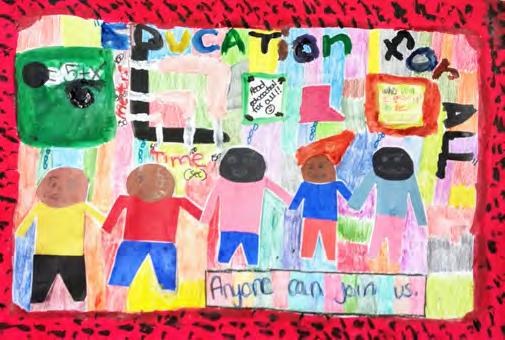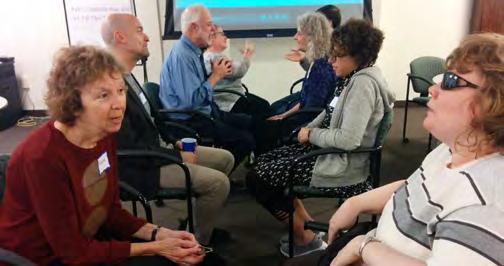
5 minute read
Education For All
EDUCATION FOR ALL - 5 Tips to Develop Your Own Support System for TAs to Improve Their Practice
By Mia Branco and Nicole Agois
Advertisement
As Teaching Artists (TAs) work hard to develop responsive teaching practices that nurture the individuality of our students, we as their administrators need to turn our attention to developing assessment practices that nurture our TAs and are responsive to the individuality of each classroom they work with. Design for assessment can be complex as there is often a wide variance in experience and training amongst TAs.

With this in mind, VSA Massachusetts’ COOL Schools Program piloted an Inclusion Support Initiative that focused on developing tools and processes for TA support and development. VSA Massachusetts, an affiliate of Seven Hills Foundation, is a nonprofit located in Boston that works at the intersection of art and disability to improve access, expand participation, change perceptions, and disseminate practices that contribute to a cultural community that truly represents all people. Our COOL Schools Program (Creative Outlook On Learning) provides instruction to more than 1,700 students of all abilities ages 3-22 each year in schools and communities across Massachusetts. COOL Schools engages partnerships between TAs and classroom teachers to develop inclusive arts-integrated learning experiences that support students’ academic, social/emotional and artistic growth through drama, dance, visual arts, movement, literary arts, and media arts.
During a staff debrief in 2016, we realized that each staff member was approaching TA support in a different way. We were not consistent or clear in our language or expectations, and this was confusing for our TAs. It was vital that we create a tool that would allow for support, language, and expectations to remain consistent and transparent no matter the staff member implementing it. Our opportunity came when we were awarded an Inclusion grant by Liberty Mutual Foundation, and we were able to embark on our Inclusion Support Initiative.
The process began with an internal brainstorming amongst VSA MA staff in which we articulated practices and began to organize trends in expectations, considerations, and processes for inclusive teaching practice. Thinking about how a TA goes about their daily practice greatly informed the language: What happens when you first enter the room? How are we usually bringing/ storing materials? Who are my resources/collaborators at the school? These many components, often unique to the TA process, formed how we structured and articulated each category and the best practices.
With our first draft created, we convened our TAs. With markers, tape, post its, and paper, we discussed, collaged, and revised the document to form a new and improved assessment tool. With language and content collectively agreed on, we then together determined the process for implementation. A big takeaway was the importance of TAs having the opportunity to express a self-assessment of their teaching before we expressed ours. This allowed the process to be a conversation that felt empowering for the TA rather than intimidating and overwhelming. This convening also gave us the opportunity to express to our TAs that we understand the complexity of the job, and that we feel it is our responsibility to make sure that they have all the support they need in this challenging work.

VSA MA’s Teaching Artists and Staff at the convening in 2016 discussing language, content, and implementation of the MICC check.
This creation process resulted in the development of the MICC Check for Inclusion, a self- assessment and coaching support tool designed to be responsive to the idea that teaching is a forever evolving practice. The MICC Check provides a set of best practices under four categories: Materials and space, Instructional techniques, Collaboration, and Classroom management. In its implementation, TAs and their COOL staff coach set a date for the MICC Check: a classroom visit and post conversation. Prior to that date, the TA uses the MICC check to self-assess, going over each of the practices listed and rating their proficiency with a + (area of strength) or a ∆ (area of growth). At this time, they also write notes to their COOL coach communicating any specific areas of growth they would like support with. During the visit, the COOL coach uses the same tool, system, and practices to frame their observations. After the visit, they have a discussion in which notes are discussed and compared, followed by setting 2-3 actionable steps for improvement. If we want our TAs to feel empowered by the feedback and support we are offering, we need to be sure that our assessment also offers clear pathways for learning. This process led our collective experience in assessment to be seen as a partnership between us, a collective commitment to learning. Based on the process we followed, here are five tips to develop your own support system for TAs to improve their practice.
1. CREATE A SYSTEM OF TRAINING AND SUPPORT
Developing a system (group meetings, one-on-one meetings, feedback mechanisms) that is consistent and predictable allows for meaningful discussion and sustainable growth. The system will allow for reliability and focus, and will help you get a clearer idea of common growth areas and how you can best support them.
2. DESCRIBE AND MODEL BEST PRACTICES UPFRONT
Setting expectations of what quality inclusive teaching and learning looks like upfront allows TAs to visualize those practices in their teaching and consider them in their planning. Getting input from TAs during the process of naming and defining these practices is essential to keep them relevant and useful in their teaching.
3. EMPLOY TEACHING ARTIST-RELEVANT LANGUAGE
Avoid academic jargon and practices that are not relevant to the contexts in which your TAs work. Keep the language concrete and understandable.

VSA MA’s Teaching Artists and Staff collage their ideas for what quality teaching looks like.
4. ALLOW SPACE FOR SELF ASSESSMENT
Provide opportunity for TAs to reflect on their strengths and growth areas and to identify the supports they would like to receive. This allows for coaching that is targeted and relevant.
5. PROVIDE IN-PERSON COACHING SUPPORTS AND ARTICULATE ACTION STEPS
Be sure your system involves coaching supports that are grounded in observation. Let the TA’s self-assessment on best practices guide the conversation and focus the tone of the discussion on growth rather than evaluation. Furthermore, work together to articulate action steps for the TA to focus on and follow up on how they are being incorporated.
About the Authors
Mia Branco is the Director of Education for VSA Massachusetts where she designs and oversees collaborations between teaching artists, schools, and cultural institutions with the goal of providing inclusive and accessible arts experiences. Before joining VSA Massachusetts, Mia was the Access Program Coordinator for Imagination Stage in Washington, DC. Mia@vsamass.org
Nicole Agois Hurel’s work centers at the intersection of art, disability and education. She directed VSA MA’s education programs for 13 years before assuming the Managing Director role. She served on the Leadership Council for the city of Boston’s cultural plan, and advises on the boards of local arts organizations. Nicole@vsamass.org www.facebook.com/VSAmass | @vsamass | LinkedIn: vsa-massachusetts

